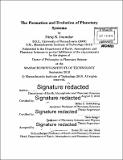| dc.contributor.advisor | Hilke E. Schlichting and Sara Seager. | en_US |
| dc.contributor.author | Inamdar, Niraj K | en_US |
| dc.contributor.other | Massachusetts Institute of Technology. Department of Earth, Atmospheric, and Planetary Sciences. | en_US |
| dc.date.accessioned | 2017-02-22T19:03:43Z | |
| dc.date.available | 2017-02-22T19:03:43Z | |
| dc.date.copyright | 2016 | en_US |
| dc.date.issued | 2016 | en_US |
| dc.identifier.uri | http://hdl.handle.net/1721.1/107104 | |
| dc.description | Thesis: Ph. D. in Planetary Science, Massachusetts Institute of Technology, Department of Earth, Atmospheric, and Planetary Sciences, 2016. | en_US |
| dc.description | Cataloged from PDF version of thesis. | en_US |
| dc.description | Includes bibliographical references (pages 299-311). | en_US |
| dc.description.abstract | The Kepler space observatory and other surveys have revealed thousands of planets and planetary systems that look significantly different from our own. In particular, the preponderance of super-Earths and mini-Neptunes (planets with radii smaller than Neptune's but larger than Earth's) at short orbital radii has challenged planet formation theories developed in the context of our own Solar System. How and where these planets form remains an outstanding question. Given the large frequency with which such planets occur around other stars, understanding the formation pathways of these planets has the potential to reveal dominant mechanisms for planet formation and evolution and to place our own Solar System within a broader context. The purpose of this thesis is to address and develop frameworks by which these questions can be answered. The thesis is comprised of two parts. In Part I, we consider the question of how and where close-in exoplanets formed. We do this in two ways. First, we use that fact that many close-in super-Earths and mini-Neptunes possess gaseous envelopes that comprise several percent or more of the total planet mass in order to construct a self-consistent planet formation history that accounts for core accretion, thermal evolution, and dynamical interactions during the core assembly process via giant impacts. We find that envelope masses accreted from the gas disc by planetary embryos are typically much smaller than those inferred for many exoplanets, and that the envelope mass fraction is further reduced substantially during the assembly phase when embryos merge. Fully assembled planets can accrete observed envelope masses from the residual disc only if energy exchange between the envelope and the underlying core is totally inhibited. It is therefore very unlikely that such planets formed at their observed semimajor axes, but instead formed further out and migrated inwards. Second, we consider the late-stage evolution of exoplanets after gas disc dissipation in order to explain the bulk structural diversity of observed super-Earths and mini-Neptunes. Whereas naive application of core accretion models suggests a narrow mass-radius relationship for these exoplanets, the population possesses a great deal of diversity in mean density. While photoevaporative mass loss from the host star is the most-commonly invoked explanation for this diversity, we use the fact that many exoplanetary systems are in tightly packed orbital configurations to propose instead that late-stage collisions are at least in part responsible for the observed diversity. We infer envelope mass fractions for planets in the literature whose masses and radii have been measured, and on the basis of this, we identify multiplanet systems whose bulk structural diversity favors late-stage impacts as opposed to photoevaporative devolatilization. In Part II, we turn our attention to the formation and evolution of our own Solar System. We do this within the context of NASA's OSIRIS-REx asteroid sample return mission. OSIRIS-REx, which launches in September 2016, will arrive at the near-Earth asteroid 101955 Bennu in 2019 with the objective of constraining its composition, orbit, and other bulk properties. In order to better understand the composition of Bennu, an instrument designed to measure its elemental abundances via X-ray fluorescence spectroscopy called REXIS was developed and built at MIT. In this part of the thesis, we investigate the ability of REXIS to constrain the composition of Bennu via fluorescence spectroscopy, as well as its potential to place Bennu within an analogue meteorite class. We carry out our analysis by modeling Solar X-ray activity and the X-ray fluorescence from Bennu, as well as by simulating data product and analysis from the instrument in order to predict REXIS's ability to carry out its goal of contextualizing Bennu within the asteroid and meteorite population. | en_US |
| dc.description.statementofresponsibility | by Niraj K. Inamdar. | en_US |
| dc.format.extent | 311 pages | en_US |
| dc.language.iso | eng | en_US |
| dc.publisher | Massachusetts Institute of Technology | en_US |
| dc.rights | MIT theses are protected by copyright. They may be viewed, downloaded, or printed from this source but further reproduction or distribution in any format is prohibited without written permission. | en_US |
| dc.rights.uri | http://dspace.mit.edu/handle/1721.1/7582 | en_US |
| dc.subject | Earth, Atmospheric, and Planetary Sciences. | en_US |
| dc.title | The formation and evolution of planetary systems | en_US |
| dc.type | Thesis | en_US |
| dc.description.degree | Ph. D. in Planetary Science | en_US |
| dc.contributor.department | Massachusetts Institute of Technology. Department of Earth, Atmospheric, and Planetary Sciences | |
| dc.identifier.oclc | 971494285 | en_US |
